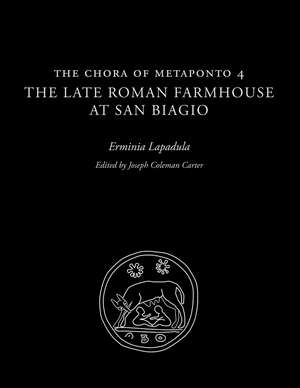The Chora of Metaponto 4: The Late Roman Farmhouse at San Biagio
Autor Erminia Lapadula Editat de Joseph Coleman Carteren Limba Engleză Hardback – 2012
Preț: 508.03 lei
Preț vechi: 659.78 lei
-23% Nou
Puncte Express: 762
Preț estimativ în valută:
97.23€ • 101.24$ • 82.17£
97.23€ • 101.24$ • 82.17£
Carte indisponibilă temporar
Doresc să fiu notificat când acest titlu va fi disponibil:
Se trimite...
Preluare comenzi: 021 569.72.76
Specificații
ISBN-13: 9780292728776
ISBN-10: 0292728778
Pagini: 256
Ilustrații: illustrations
Dimensiuni: 216 x 279 x 20 mm
Greutate: 1.13 kg
Ediția:New.
Editura: University of Texas Press
Colecția University of Texas Press
ISBN-10: 0292728778
Pagini: 256
Ilustrații: illustrations
Dimensiuni: 216 x 279 x 20 mm
Greutate: 1.13 kg
Ediția:New.
Editura: University of Texas Press
Colecția University of Texas Press
Notă biografică
Erminia Lapadula is an archaeologist currently working with the Archaeological Superintendency of Basilicata and the Institute of Classical Archaeology at the University of Texas at Austin. She has participated in numerous archaeological excavations in Italy and abroad and published in journals and collective works on Roman and Medieval archaeology, with special attention to Roman Medieval pottery items and clothing accessories in the Middle Ages.
Joseph Coleman Carter is Director of the Institute of Classical Archaeology at the University of Texas at Austin. He is a former fellow of the American School of Classical Studies at Athens and the American Academy in Rome.
Joseph Coleman Carter is Director of the Institute of Classical Archaeology at the University of Texas at Austin. He is a former fellow of the American School of Classical Studies at Athens and the American Academy in Rome.
Cuprins
- Acknowledgments
- Preface (Joseph Coleman Carter)
- 1. The Farmhouse at San Biagio and the Agricultural Landscape of Basilicata in the Roman Period (Liliana Giardino)
- Introduction
- Basilicata under Roman Rule
- 2. The Excavation and Structures (Erminia Lapadula)
- The Setting
- The 1980 Excavation
- Re-evaluation of the Site’s Occupation
- Building Materials
- Interpretation of the Roman Structure
- Virtual Archaeology: A Proposed Reconstruction (Massimo Limoncelli)
- 3. The Materials: Prehistoric through the Roman Republican Period (Erminia Lapadula)
- Introduction
- Pottery and Other Neolithic Artifacts (Cesare D’Annibale)
- Figured Pottery (Francesca Silvestrelli)
- Black Gloss and Grey Ware (Eloisa Vittoria)
- Banded Ware, Miniatures, and Plain Ware (Anna Cavallo)
- Cooking Ware (Antonietta Di Tursi)
- Transport Amphorae (Oda Teresa Calvaruso)
- Architectural Terracottas (Anna Lucia Tempesta)
- Coroplastic (Rebecca Miller Ammerman)
- Loom Weights (Lin Foxhall)
- 4. The Materials: The Roman Imperial Period (Erminia Lapadula)
- Study and Presentation of Material
- Eastern Terra Sigillata
- African Red Slip Ware
- Slipped Common Ware
- Plain Ware
- African Cooking Ware
- Cooking Ware
- Transport Amphorae
- Dolia
- Glass Finds
- Metal Finds
- Milling Finds
- 5. Furnishings, Utilitarian Artifacts, and Coins (Erminia Lapadula)
- Introduction
- Personal Artifacts
- Household Instruments
- Spinning, Weaving, and Sewing
- Lamps
- Tools for Fire-lighting, Carpentry, and Woodworking
- The Repair of Dolia
- Window Glass
- Coins (Anna Rita Parente)
- 6. Archaeozoology, Archaeometry, and Ceramic Analysis
- The Archaeozoological Data (Joseph Coleman Carter)
- A Goat Skeleton from the Roman Period (László Bartosiewicz)
- Archaeometric Analyses of Metal, Glass, and Plaster (Claudio Giardino)
- Microscopy of Selected Pottery Fabrics (Keith Swift with Victoria Leitch)
- 7. Conclusions (Erminia Lapadula)
- Reference Materials
- References
- Index
- Illustration Credits
Recenzii
This beautifully-produced volume forms part of the rapidly expanding series of publications resulting from the long-term fieldwork directed by Joseph Coleman Carter across the hinterland (chora) of the Greek colony of Metaponto, on the instep of the Italian boot...In summary, this is an exemplary report: well-contextualised, neatly summarised, beautifully-illustrated (especially the maps), and well worth the wait.
Descriere
Based on archaeological investigations in southern Italy by the Institute of Classical Archaeology, this volume features a small but viable social and economic entity that was an unexpected find from a period generally marked by large landholdings.
